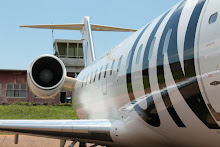First Hurdle Cleared
This morning (bright and early at 5 a.m.) was our initial sim evaluation. It's pass/fail and marks the end of the Launch Program. My partner has less experience with RJ systems so our instructor spent a good deal of time showing him synoptics pages on the EICAS (Engine Information and Crew Alerting System). The EICAS pages have a great deal of information about the CRJ which is a very video intensive aircraft.
After the systems refresher, it was my turn to fly. I did some low RVR (Runway Visual Range) takeoffs, some hand flown and coupled departure procedures, course intercepts, direct-to intersections and other flight plan amendments. Then the instructor vectored me for some CAT II ILS approaches, both hand flown and coupled with the auto pilot. Since we were ahead of the Launch curve, we had a little extra time to fly a few missed approaches too.
As mentioned earlier, Launch is designed to be an introduction to the CRJ for the uninitiated. There's nothing difficult like V1 cuts, rejected takeoffs, rejected and balked landings or emergencies. Very straight forward with no surprises.
My partner and I both passed launch and can check off the first phase of Part 121 training at our airline. Passing the first milestone feels great.


This is the captain's seat. In a real CRJ, there is a fuse panel directly behind it. In the sim, it is on hinges and rotates out of the way to make a clear view for an observer. The seats are very comfortable and infinitely adjustable. Unfortunately, the flash washes out the view from the cockpit.
The other important panel is the overhead. It houses controls for these systems: electrical, fire detection, lighting, fuel management, 10th & 14th stage bleed air, APU (Auxiliary Power Unit), Engines, hydraulics, pressurization, air-conditioning, and anti-ice.
There are more buttons and levers, but that's enough for today. My fingers hurt.

4 comments:
Congratulations on passing the first hurdle! You've come a long way from the GA world where it can be difficult to find an aircraft that airworthy. I'll be interested in reading more on your initial training.
Thanks John,
I hope that airworthiness isn't ever an issue!
LOOKING GOOD! from JP in IL. Have fun with the family and keep the info coming.
This is great info to know.
Post a Comment